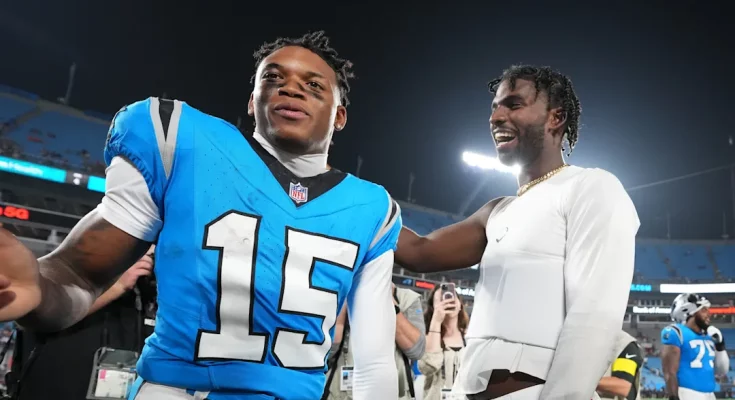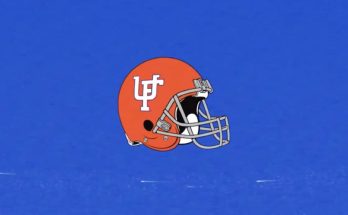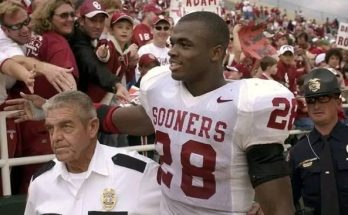The Carolina Panthers have long been defined by tradition, especially at the wide receiver position, where the franchise has often leaned on a certain mold of player that fits both their offensive schemes and cultural identity. From the early days of their existence in the NFL to more recent years, the team has maintained a distinct philosophy at wideout—favoring receivers who embody physicality, toughness, and reliability over flashiness or pure finesse. That formula has produced iconic names and unforgettable moments for the franchise, but according to insider reports, the Panthers appear ready to pivot from this long-standing tradition in favor of a bold new direction. This projected shift not only signals a change in roster construction but also reflects deeper themes about where the organization stands today, the evolution of the NFL itself, and the urgency the Panthers feel to re-establish themselves as a true contender in a league that thrives on innovation and adaptability.
Historically, when fans think of Carolina Panthers wide receivers, certain archetypes and names immediately come to mind. The legendary Steve Smith Sr., who spent 13 years with the team, embodies what many consider the prototypical Panthers wideout: undersized yet fearless, defined by toughness, a fiery personality, and an ability to make clutch plays when it mattered most. Smith wasn’t the biggest receiver, but his aggressive style of play, precision in route running, and ability to win contested catches made him not just a franchise icon but one of the most respected players of his era. Following in his footsteps, the Panthers often opted for receivers who emphasized grit over glamour. Whether it was Muhsin Muhammad’s steady, reliable presence in the early 2000s or the likes of Jerricho Cotchery and others who contributed in more complementary roles, the team’s receiver corps rarely leaned into the “diva wideout” stereotype that has often defined other franchises. Instead, Carolina prized discipline, blocking ability in the run game, and receivers who could endure physical play in tightly contested NFC South matchups.
Yet as the NFL has shifted to a pass-heavy league dominated by explosive playmakers on the perimeter, Carolina’s adherence to its traditional mold has started to look more like a limitation than a strength. Teams across the league now covet receivers who can stretch the field, create separation with elite speed and agility, and serve as game-changing threats who demand double teams. In recent years, franchises like the Kansas City Chiefs, Miami Dolphins, and Philadelphia Eagles have reaped the rewards of embracing modern receiver archetypes, surrounding their quarterbacks with weapons who fundamentally alter defensive strategies. The Panthers, meanwhile, have struggled to keep pace. Despite drafting wide receivers in recent years, the team has lacked the consistent star power at the position needed to elevate their passing game.
This insider report suggesting a break from tradition is therefore more than just a personnel note—it reflects a recognition within the Panthers’ front office that the old model is no longer enough to win in today’s NFL. The projection hints that Carolina could be targeting a new kind of wideout, perhaps one who embodies speed, flash, and explosiveness more than the toughness and possession-style reliability that has long been prioritized. Such a change would have ripple effects not only on the field but also in how the team is perceived. For years, Panthers fans could point to their receivers as extensions of the team’s gritty, hard-nosed identity. To pivot away from that would symbolize an embrace of the NFL’s modern realities, even if it means letting go of the franchise’s old comfort zones.
The timing of this projected shift is telling as well. The Panthers are in a moment of redefinition, with young quarterback Bryce Young entering a critical stretch of his development. For a player drafted to be the face of the franchise, surrounding him with weapons that can maximize his skill set is not just preferable but essential. Young’s accuracy, processing speed, and poise have long been cited as his strengths, but without receivers capable of creating separation and stretching defenses, those traits risk being underutilized. Carolina’s front office knows this, and insiders suggest that their willingness to break with wide receiver tradition is directly tied to building an ecosystem where Young can succeed. This represents a practical acknowledgment: sticking with old philosophies may no longer serve the future.
One of the interesting aspects of this potential pivot is how it could reshape fan expectations. For decades, Panthers supporters have embraced the rugged identity of the franchise, often proud of the fact that Carolina leaned on defense, running backs, and grinders at wide receiver rather than showmen. If the team now invests in high-profile, speed-oriented receivers—players more in line with Tyreek Hill, Justin Jefferson, or Ja’Marr Chase—it would represent a cultural shift as much as a tactical one. Fans who once celebrated grinding out tough wins with possession receivers may soon find themselves cheering for 70-yard touchdowns and highlight-reel catches. While this would be an exciting new brand of football, it could also cause a nostalgic tension for those who remember the old days.
Moreover, insiders suggest this isn’t just a matter of one draft pick or free-agent signing—it’s part of a broader organizational plan. The Panthers have reportedly been re-evaluating how they scout and prioritize wideouts, placing more emphasis on separation ability, deep speed, and after-the-catch potential than they have in the past. If true, this signals a deliberate and systemic pivot rather than a one-off exception. That kind of change suggests the team understands how the NFL has evolved and that clinging to tradition can leave franchises behind.
The practical side of this also raises interesting questions. If the Panthers do indeed pursue a new mold of receiver, how will that affect their existing roster? Current wideouts who fit the old identity may find themselves in different roles, asked to complement the flashier new additions rather than serve as the centerpiece. It may also impact how the team allocates resources, as investing in top-end receivers often requires high draft picks or significant cap space. Balancing those costs with other roster needs—particularly along the offensive line and defense—will be a challenge for the front office. Yet, given the urgency to develop Bryce Young and energize the fan base, insiders suggest the team is prepared to make those investments.
This projected departure from tradition also speaks to the broader narrative of the Panthers as a franchise searching for a new era. Since their Super Bowl 50 appearance nearly a decade ago, Carolina has struggled with instability at quarterback, frequent coaching changes, and inconsistency on the field. To some extent, the franchise has been stuck between holding on to its old identity and embracing the modern NFL. The insider report hints that the Panthers may finally be choosing a lane, and that choice is toward innovation and alignment with the league’s offensive trends. Such a move could pay significant dividends if executed properly, but it also carries risks. If the team misidentifies the right receiver talent or struggles to integrate them into the offense, the gamble could set back Bryce Young’s development and fuel further frustration among fans.
Still, many would argue that the greater risk lies in doing nothing—sticking with a receiver model that no longer yields results in today’s game. By being willing to break with tradition, the Panthers at least signal that they are aware of the competitive gap and are prepared to act. That awareness, combined with a willingness to adapt, could mark a turning point for a franchise in desperate need of forward momentum. For fans, the coming months and seasons will provide clarity on whether this projected change delivers the kind of excitement and results that have been missing.
Ultimately, the insider report about Carolina’s wide receiver plans is about more than just roster construction. It’s a reflection of how franchises evolve, how traditions can both define and constrain, and how the NFL’s relentless pace of change forces teams to adapt or risk irrelevance. For the Panthers, this projected pivot could be the first step toward a brighter, more dynamic future—one where the passing game is no longer a limitation but a weapon, where Bryce Young has the tools he needs to thrive, and where fans can embrace a new kind of identity without forgetting the proud traditions of the past. If executed correctly, Carolina’s decision to depart from its long-standing wide receiver mold may not just be a break with tradition but the foundation of a new legacy.



